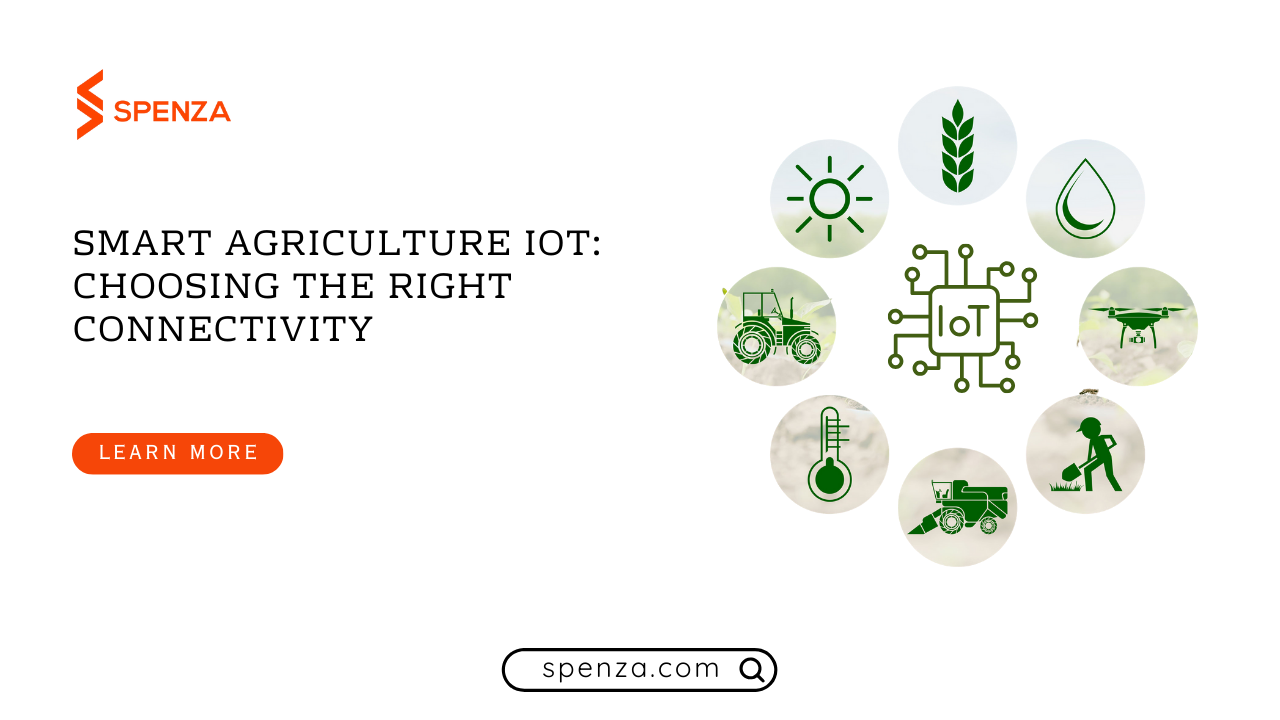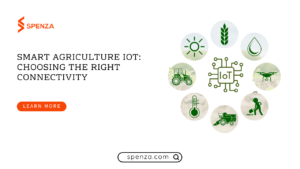TL;DR / At-a-Glance Summary
Why Connectivity Matters in Smart Agriculture IoT
Smart agriculture IoT fails fast when the connectivity breaks. Strong coverage, battery-friendly protocols, and simple device onboarding keep every sensor online and working without field headaches.
IoT Connectivity in Modern Farming
Farmers connect soil sensors, pumps, drones, and trackers. IoT connectivity for agriculture keeps these systems steady, reducing manual work and improving real-time decisions in growing fields and remote plots.
NB-IoT & LTE-M for Agriculture
NB-IoT agriculture and LTE-M in farming support rugged field conditions. These choices help devices send data even when coverage remains weak or power stays very limited inside the farm.
Satellite IoT for Remote Farming
Satellite IoT for smart farming helps farmers connect sensors in very remote lands. It works when no terrestrial network reaches water points, hills, orchards, or wide grazing fields.
Spenza for Agricultural IoT Connectivity
Spenza simplifies multi-network IoT through eSIMs, automated switching, and centralized management. It keeps agriculture IoT devices online across regions without manual network checks or extra fieldwork from teams.

Smart agriculture IoT devices rely on stable, wide-area connectivity to operate across large rural fields. Each farming application requires the right network—whether low-power, long-range, or satellite-based. Robust IoT connectivity for agriculture boosts efficiency, supports real-time monitoring, and keeps modern farms reliably connected.
Building the Future of Connected Farming
What stops a wide farm from getting real-time soil or crop data at the moment it matters most? Smart agriculture IoT answers this, as more than 18.5 billion IoT devices operate globally in 2024 and agriculture uses a large share of them. IoT connectivity for agriculture becomes essential when soil sensors, livestock trackers, irrigation controllers, and climate stations sit far from towers.
These devices need networks that stay steady through weather, distance, and scale. Choosing the right network shapes success on the field. In this blog, you see how each option fits real farm needs and trade-offs.
Many teams use guides like Spenza’s IoT connectivity types guide to understand these choices. This shift boosts sustainability and efficiency across agriculture. But what exactly is smart agriculture IoT? Let’s dive in.
What is Smart Agriculture IoT?
Smart agriculture IoT brings connected sensors into fields, orchards, and barns so farmers make faster decisions. These sensors track soil conditions, water levels, climate patterns, and livestock activity. IoT connectivity for agriculture supports this movement because farmers react quickly when data stays constant.
Studies show that IoT-based precision agriculture can increase yields by up to 20% , which makes strong connectivity important. NB-IoT agriculture fits static sensors, while LTE-M in farming fits moving assets. Precision farming connectivity grows better when farms match each sensor to the right network.
Smart agriculture IoT depends on devices that run on small batteries. These devices may sit kilometers away from towers or routers. IoT connectivity for agriculture matters because a sensor that stays offline brings wrong field decisions. NB-IoT agriculture and LPWAN fit slow-moving devices. LTE-M in farming fits livestock and machinery.
Satellite IoT for smart farming helps remote sensors far from terrestrial coverage. IoT network architecture in agriculture grows stronger when farms design hybrid stacks that suit all terrains. Smart agriculture IoT runs smoother when networks reflect real field needs.
With a better understanding of these devices, it’s clear how essential the right connectivity is. So, let’s look at why connectivity is the backbone of smart farming.
A sensor that performs well at noon can fail at dawn when temperature inversions distort signal paths. Early-morning field tests expose these real connectivity challenges and reveal the true reliability of agricultural IoT devices.
Why Connectivity is the Backbone of Smart Agriculture?
Smart agriculture IoT only works when sensors send data without delay. IoT connectivity for agriculture must stay strong in soils, hills, orchards, and barns. Farms use thousands of small battery devices. Each device sends vital readings that guide irrigation, pest control, and planning. Therefore, networks must hold a stable link even when distances grow long.
Many farms now rely on sensor-driven irrigation because IoT-enabled smart irrigation can save 20–50% water. NB-IoT agriculture supports deep coverage. LTE-M in farming supports moving assets like cattle and tractors. Satellite IoT for smart farming keeps isolated land online. Precision farming connectivity relies on this constant flow of sensor updates.
Key reasons connectivity matters:
- Sensors sit in remote zones with weak tower reach.
- Power stays limited for battery devices.
- Devices send frequent updates.
- Data accuracy affects crop yield.
- Farms grow across large areas.
For deeper background, some teams explore IoT device connectivity to design better plans. Now, let’s take a closer look at the different connectivity options available for agriculture IoT.
Common Connectivity Options in Agriculture IoT
IoT connectivity for agriculture offers many choices because no single network fits all farms. Soil sensors use low power. Weather stations send more updates. Tractors need real-time data. Livestock collars move far. Each needs a specific network. NB-IoT agriculture and LTE-M in farming support long-range battery devices.
Cellular IoT for agriculture manages high bandwidth. Satellite IoT for smart farming covers dead zones. IoT sensor connectivity agriculture becomes easier when farms understand these trade-offs. IoT network architecture in agriculture often mixes networks.

LPWAN Technologies
LPWAN technologies support long-range coverage and small battery devices, which makes them a top choice for wide farms. IoT connectivity for agriculture stays efficient because LPWAN sends small packets that last years.
The global demand for these systems grows fast, and reports show the LPWAN for agriculture market may reach USD 6.8 billion by 2033 at a 21.7% CAGR . This makes LPWAN a stable option for soil sensors, weather stations, and slow-moving tools. Precision farming connectivity becomes easier because one gateway often covers an entire field.
Features of LPWAN
- Long coverage
- Small packets
- Great battery life
- Good for soil sensors
- Works across large acreage
Cellular (4G/5G)
Cellular IoT for agriculture supports higher data loads. Smart agriculture IoT uses cellular networks for drones, machinery, cameras, and weather dashboards. LTE-M in farming fits moving assets that need more frequent updates. NB-IoT agriculture fits sensors with small updates. These networks help farms handle more automation.
Features of Cellular Networks
- Good bandwidth
- Strong tower coverage
- Works for video tasks
- Supports moving assets
- Used for gateway backhaul
To understand global cellular behavior, many agritech operators use IoT connectivity plans.
Satellite IoT
Satellite IoT for smart farming supports fields far from cellular towers. Smart agriculture IoT sensors in mountains, rangelands, and large open tracts depend on satellite as the last-mile link. Farms use it for high-value endpoints only because satellite plans cost more.
Where Satellite Helps
- Water tanks
- Orchards in hills
- Long grazing routes
- Remote pumps
- Uncovered crop belts
Wi-Fi / Mesh
Farms use Wi-Fi where power stays available. Indoor barns, packhouses, and greenhouses use mesh systems. Smart agriculture IoT tasks like temperature control, livestock monitoring, and greenhouse climate sensors run well indoors. IoT sensor connectivity agriculture improves indoors because walls block less signal.
Best Uses of Wi-Fi / Mesh
- Barns
- Greenhouses
- Storage buildings
- Processing rooms
- Solar-powered hubs
Mesh often acts as a local network tied back to a 4G router. Now that we’ve covered the most common network types, let’s discuss some key challenges and how Spenza addresses them.
“Full bars” on a phone don’t guarantee reliable IoT coverage. Most agricultural IoT devices transmit at lower power and experience the field very differently, making real-world testing essential.
Key Challenges in Agriculture IoT And How Spenza Solves Them
Smart agriculture IoT systems face real field issues. IoT connectivity for agriculture must work across spread-out farms. NB-IoT agriculture or LTE-M in farming may fail in some areas. Satellite IoT for smart farming fills extreme gaps but costs more. IoT network architecture in agriculture becomes complex when farms run many device types.
IoT sensor connectivity agriculture remains steady only when networks switch smoothly. This is where Spenza helps, especially with tools like IoT eSIM connectivity and SIM orchestration.

Coverage Gaps in Rural Areas
Farm signals drop in valleys, hills, and deep fields. NB-IoT agriculture offers better coverage but still hits blind spots. LTE-M in farming helps moving devices but drops at edges. Satellite IoT for smart farming fills these pockets.
Managing Thousands of Devices
IoT connectivity for agriculture grows fast. Farms deploy thousands of sensors. Manual SIM tasks become heavy. IoT network architecture in agriculture needs automation. NB-IoT agriculture, LTE-M in farming, and satellite IoT stack together and need one dashboard.
Cost Control for Large Deployments
Smart agriculture IoT becomes expensive when each device uses its own bill. Cellular IoT for agriculture sometimes wastes data. LPWAN helps cut cost. Precision farming connectivity stays cheaper when farms design the right bundle.
Power & Bandwidth Efficiency
Smart agriculture IoT devices run on batteries. They need networks that fit low power. LPWAN and NB-IoT agriculture fit tiny packets. LTE-M in farming fits frequent updates. Satellite IoT for smart farming fits big distances.
Scalability Across Fields & Regions
Large farms spread across regions. IoT connectivity for agriculture must remain stable everywhere. IoT sensor connectivity agriculture scales when farms design a hybrid stack. IoT network architecture in agriculture supports long-term expansion.
To solve these challenges, let’s explore how Spenza’s connectivity solutions help streamline and simplify operations.
Spenza: The Connectivity Layer That Keeps Agriculture IoT Online
Smart agriculture IoT becomes hard to maintain when farms deal with weak signals, mixed networks, and thousands of devices. Spenza solves these challenges by sitting between devices and networks as a unified connectivity layer. It lets farms use NB-IoT agriculture, LTE-M in farming, cellular IoT for agriculture, and even satellite IoT for smart farming without the usual complexity.
Spenza automates network selection so every device uses the strongest available signal. It also prevents wasteful data bills and keeps all SIMs visible from one dashboard. IoT network architecture in agriculture becomes clean because farms control everything from a single place.
How Spenza helps agriculture deployments:
- Multi-network eSIM support so devices switch between carriers automatically
- Real-time SIM orchestration that picks the best signal in each farm zone
- Centralized dashboard for IoT sensor connectivity agriculture across regions
- Usage controls to avoid data overages in cellular IoT for agriculture
- Global network reach with unified billing and simplified activation
- Remote troubleshooting to reduce field visits
- Support for hybrid setups using NB-IoT, LTE-M, LPWAN, and satellite
- Scalable management for thousands of devices across many states
- Better uptime through automated fallback rules
How to Choose the Right Connectivity for Smart Agriculture
Smart agriculture IoT becomes easier when farmers use a checklist. IoT connectivity for agriculture changes by device type, terrain, and data size. NB-IoT agriculture fits sensors. LTE-M in farming fits moving tools. Satellite IoT for smart farming fits remote sensors. IoT network architecture in agriculture grows cleaner with planned structure.

Identify the Type of IoT Devices
Farms must first list the devices they plan to deploy. Soil sensors send small packets from the ground and need low power. Weather stations send more frequent updates from fixed positions.
Livestock trackers move across fields and need stronger mobility support. Irrigation controllers trigger actions and need timely downlink. Drone dashboards send higher data loads when active. Knowing these device types shapes the right network choice.
Understand Data Requirements & Frequency
Each device sends data at different rates. Low-frequency sensors fit LPWAN or NB-IoT agriculture because they send tiny packets. Medium-frequency devices fit LTE-M in farming because they move and update often.
High-frequency devices use cellular IoT for agriculture because they push larger data. Remote sensors rely on satellite IoT for smart farming when no tower reaches them. Matching frequency to network keeps systems stable.
Evaluate Coverage in the Farm’s Region
Farm teams must test ground-level signal across fields, orchards, and grazing routes. Some areas support NB-IoT agriculture, while others support LTE-M in farming better. Hybrid stacks often solve patchy zones. Coverage testing early prevents future connectivity issues.
Consider Power Consumption
Battery life guides network choice. Low-power sensors work best on NB-IoT agriculture or LPWAN because these networks support long sleep cycles. Cellular IoT for agriculture suits devices with more power. Choosing the right network helps sensors last for years without frequent field visits.
Assess Scalability & Maintenance
Smart agriculture IoT grows fast, so farms need flexible systems. The network must support more devices across seasons. Adding sensors should stay simple, not complex. Good planning supports expansion, smooth maintenance, and easier long-term growth.
Now that we’ve covered how to choose the right connectivity, let’s look at some key use cases.
Low-power IoT protocols perform best with short, consistent data bursts. Sudden spikes in transmission can disrupt network scheduling and increase packet loss, reducing overall farm device reliability.
Use Cases in Smart Agriculture IoT
Smart agriculture IoT supports many operations. IoT connectivity for agriculture keeps the following tasks running daily:
| Use Case | Description |
|---|---|
| Irrigation Automation | Automates watering based on soil moisture levels and weather predictions, optimizing water usage. |
| Livestock Health Tracking | Tracks animal movement, health, and behavior in real-time for better herd management. |
| Crop Disease Alerts | Detects and alerts farmers to early signs of crop diseases, enabling timely intervention. |
| Weather Forecasting | Provides local weather data to help farmers plan farming activities, reducing risks of weather-related losses. |
| Soil Condition Reporting | Monitors soil health, moisture, and temperature to ensure optimal growing conditions for crops. |
| Storage Monitoring | Monitors storage conditions like temperature and humidity to preserve harvested crops and reduce spoilage. |
Precision farming connectivity supports these tasks with constant data. IoT network architecture in agriculture keeps everything tidy.
Benefits of Using IoT Connectivity Platforms in Smart Farming
Smart agriculture IoT deployments run easier when farms use platforms. IoT connectivity for agriculture improves because teams avoid manual SIM tasks. NB-IoT agriculture and LTE-M in farming scale fast. Satellite IoT for smart farming fits easily. IoT sensor connectivity agriculture stays stable because teams monitor all networks from one place.
- Centralized monitoring: Teams can track all devices and networks from a single dashboard, ensuring seamless data flow.
- Automated network management: Platforms like Spenza ensure devices automatically connect to the best available network, reducing manual intervention.
- Scalability: NB-IoT agriculture and LTE-M in farming scale quickly as more sensors are added, without adding complexity.
- Reduced operational overhead: Satellite IoT for smart farming integrates easily, offering reliable connectivity even in remote regions.
- Stable connectivity: IoT sensor connectivity agriculture remains steady as the platform optimizes network selection, reducing downtime.
Precision farming connectivity becomes more reliable. IoT network architecture in agriculture becomes easier to manage. Many decide to use unified systems similar to Spenza’s methods explained in global IoT MVNO connectivity.
Future Trends in Smart Agriculture and IoT Connectivity
Smart agriculture IoT keeps expanding as farms adopt multi-network systems. IoT connectivity for agriculture grows stronger when farms plan for hybrid stacks that mix NB-IoT agriculture, LTE-M in farming, and satellite IoT for smart farming. Many regions now see faster adoption because connected tools raise efficiency.
Reports show India’s agriculture IoT market generated USD 1.39B in 2024 and may reach USD 2.12B by 2030 , showing how quickly connected farming rises. IoT network architecture in agriculture will rely more on eSIM, iSIM, and automated switching.
IoT network architecture in agriculture grows more automated. Precision farming connectivity pushes farms to adopt more multi-network setups. Many consider new standards like eSIM and iSIM from guides such as iSIM vs eSIM.
Conclusion: Advancing Connected Farming with Reliable IoT Networks
Smart agriculture IoT grows smoother when farms pick the right connectivity. IoT connectivity for agriculture depends on terrain, crop type, and device count. NB-IoT agriculture fits static sensors. LTE-M in farming supports movement. Satellite IoT for smart farming fits remote land. Cellular IoT for agriculture manages bandwidth-heavy tasks. Precision farming connectivity works best when networks run together.
IoT sensor connectivity agriculture grows more efficient with better planning. IoT network architecture in agriculture builds a long-term foundation for growth.
Which network aligns with your farm’s goals today? Pick your connectivity path now and move ahead with systems that stay online even in tough field conditions.
FAQs
Yes, many farms mix LPWAN, NB-IoT, LTE-M, cellular, and satellite because each device needs a different level of power, distance, and data.
LTE-M fits moving devices like livestock collars or tractors. It updates more often while keeping power low.
Farms scale easier with platforms that automate SIM control, data limits, and switching. This prevents manual work during large deployments.
Contact Spenza now to streamline your agriculture IoT and boost farm efficiency.






